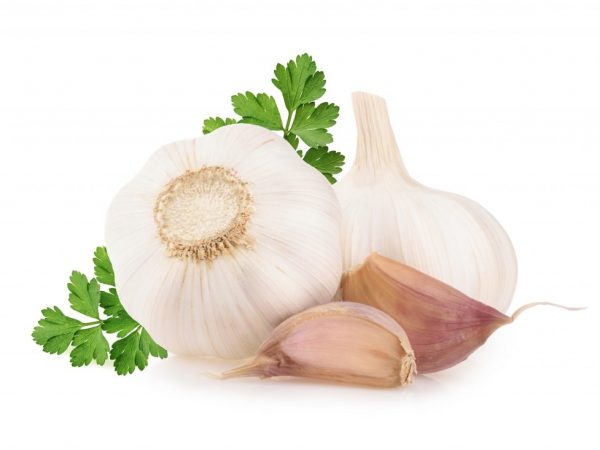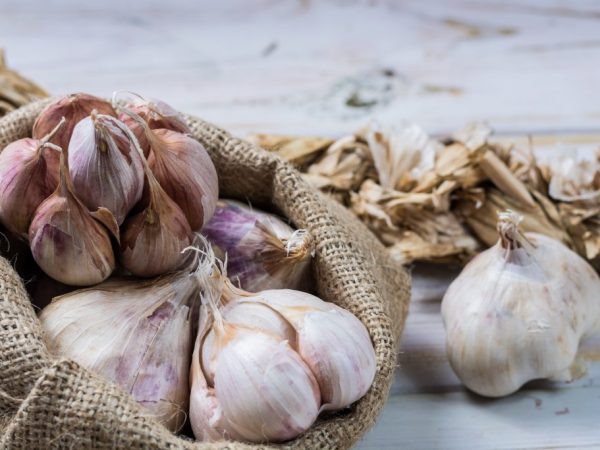How to feed garlic for the winter
Garlic is one of the most popular vegetable crops. On the one hand, it is a healthy and indispensable vegetable. On the other hand, it is the most demanded culinary spice, which is used in the preparation of various dishes. Of course, every summer resident, planting it on his site, dreams of growing and harvesting a good harvest. It is not difficult to do this - the main thing is to properly organize the fertilization of the garden bed. So, how to feed garlic for the winter and do you need to fertilize it at all?

Top dressing of garlic for the winter
Why fertilize
Before carrying out the feeding procedure, you need to understand why it is needed at all. If you are going to grow winter garlic, then fertilizers must be applied immediately in the process of planting seedlings, that is, in the fall. The fact is that this variety needs nutrients in order to gain strength over the winter, and after the onset of good weather, it actively grows.
If you prefer spring garlic (planted in spring), keep in mind that fertilizing the soil in autumn will help enrich it with useful substances, and spring garlic will be a good stimulation for growth. Thus, fertilizers will help the vegetable crop to receive the necessary energy boost. In addition, garlic needs additional feeding in the summer. It helps the plant to become stronger, as a result of which it will not be afraid of temperature drops, diseases, or pests.
Fertilizer before winter
It is important to correctly determine the place where the vegetable will be grown. Do not forget that garlic is quite picky about the soil. Since it does not tolerate acidic soils, it must be planted in neutral soil. To grow a good harvest, the site must be prepared in advance in the fall: clean it of leaves and wilted plants, dig deep into the ground.
Top dressing in the fall will help you grow a great crop. Fertilizers can be applied, both in the process of planting a winter variety, and as a preparation of the soil for cultivation in spring. Most often, various organic and inorganic substances are used as fertilizers during this period, which today can be easily found in any specialized store or on the market.
Please note that the use of nitrogen fertilizers is contraindicated for winter garlic. Since they activate the intensive growth of the tops, and a strong root system is needed to form large denticles.
Winter variety
Winter garlic, as a rule, begins to be planted at the twentieth of September, so that by the time of the first frost it has time to take root, so preparatory work must be started a few weeks before.
To begin with, on the site chosen for planting a vegetable, it is necessary to form grooves, and then fertilize the soil with useful substances. You can use regular humus as a top dressing.Any superphosphates (based on a tablespoon for one bucket of manure) will serve as an excellent nutritional supplement to it.
Spring variety
In order for the planted vegetable to take root, survive the winter well and begin to actively gain growth, universal fertilizers, which can be bought in any specialized store, will be quite enough.
Please note that autumn feeding is absolutely necessary if you are going to grow a spring variety that is planted in the ground at the end of winter.
Fertilizer after winter
It is very important to properly fertilize the soil before planting the cloves in it. This will ensure that you reap an excellent harvest in the spring. Do not forget that before planting, the soil must be treated with copper sulfate without fail in order to disinfect it from harmful diseases and microorganisms, and then dig it up thoroughly.
When preparing the soil, other nutrients are also used. As a fertilizer for garlic, slurry is often used for the winter. It is not difficult to get it. The manure must be diluted with plain water in a ratio of 1 to 6. During the growing season, 2-3 procedures of such feeding should be carried out. You can also use wood ash - this fertilizer is preferred by many gardeners.

You need to fertilize both garlic and soil.
Spring variety
With the onset of warm sunny weather, the plant is especially in need of nutrients and nutrients. In the spring, both spring and winter varieties are fed without fail. Gardeners have developed a special schedule for these purposes.
Fertilizers must be applied with a difference of 2 weeks after the first procedure. Use nitrophos for this - for 1 m2 of soil, at least 3 liters of a substance diluted with water.
Winter variety
The winter variety is fed for the first time as soon as the weather is good and the last snow melts. Spring garlic - only after the plant has released the first few leaves. In this case, it is best to use urea (urea solution) in the calculation of 1 tbsp. l. on a bucket of water, repeat after two weeks.
The last time minerals should be added at the end of the growing season, sometime at the end of June. Use superphosphate as a fertilizer (at least 5 liters per 1 square meter of land).
Top dressing for seedlings
At the end of winter, it is very important to organize feeding for the seedlings. In this case, it is imperative to observe the above terms. Because if you miss at least one procedure, it can negatively affect the future harvest. The first and second dressings depend on how quickly the plant rises, so the timing of their implementation can vary significantly. But the last feeding should be organized exactly at the specified time. Otherwise, all the strength of the plant may be spent on growing arrows, not bulbs.
How to fertilize a vegetable
If you decide to use inorganic substances, you can easily find them in a specialized store. The main thing before using them is to carefully study the instructions in order not to be mistaken in the proportions, and not to harm the future harvest. Phosphate and potash fertilizers are best applied after good soil moisture. The fertilizer mixture must be scattered around the plants at the rate of 10 g per 1 sq. m. You can also dilute this mixture in water, and pour it over the soil abundantly (at the rate of 3 liters of water per 1 sq. m.).
The following combinations of fertilizers are no less effective:
- 3 kg of humus;
- 1 tbsp. l. superphosphate and nitrophosphate;
- 1 tbsp. l. wood ash.
Or this option: 4 kg of humus, 20 g of superphosphate and 15 g of potassium. Manure and ash are suitable as organic substances. In no case should you use fresh humus, as it will instantly burn your seedlings. For these purposes, settled manure, which has already managed to rot, is suitable.Water your garden beds with this solution, being careful not to get on the green leaves of the plant.
Excellent fertilizer and common salt. Its solution will not only speed up the growth of the plant, but also prevent the leaves from drying out and turning yellow during hot weather. If you water the earth with a saline solution, then it will serve as an excellent disinfectant, which will prevent the spread of many pathogenic microbes.
Features of foliar feeding
Experienced gardeners often use in their practice this type of feeding, as foliar fertilization. During it, substances are sprayed onto the leaves and stem, which contributes to the faster assimilation of useful trace elements. This feeding method is used if the plant needs emergency assistance.
Please note that in this case, the fertilizer should be less concentrated. The feeding procedure should be carried out late in the evening after the heat has subsided and the sun has set. Foliar dressing cannot be carried out more than twice a season and in no case can it serve as a substitute for the main fertilization procedure.
Increasingly, green manure plants are planted next to garlic to supply the soil with nutrients. They not only nourish the soil, but also normalize its acidity level. For these purposes, legumes and cereals are best suited. For this method to work and give a positive effect, green manure plants must be cut off when they just begin to gain strength. A few weeks before planting the garlic, they must be distributed over the land specially designated for this purpose. They will rot and thus fertilize the earth with useful substances.
Conclusion
Fertilizing garlic in the autumn, as well as after the end of winter, is an important and necessary event. This procedure must be carried out without fail, otherwise you will not be able to grow and harvest a bountiful harvest.
When feeding a plant during planting, do not forget to observe the proportions of the combined substances. In this case, it is imperative to take into account the composition of the soil and the variety of the grown vegetable (winter or spring). If you follow the advice and follow the established feeding times, you will definitely get an excellent harvest. The main thing to remember is that you must fertilize the garlic.


